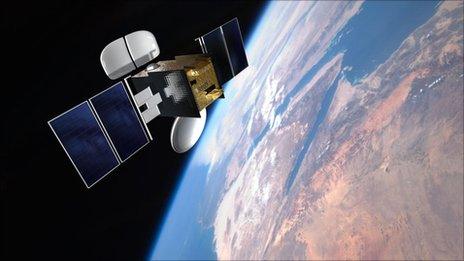Can sky-high broadband take off?
- Published

A satellite dedicated to plugging some of the holes in the UK and Europe's broadband coverage finally takes to the skies this week.
The spacecraft, called Hylas 1 (Highly Adaptable Satellite), was scheduled to launch at the end of last year but will now go into orbit on 26 November.
The UK government may see the launch as an answer to its prayers as it races to provide all homes with a minimum 2Mbps broadband connection by 2015.
But others have questioned the relevance of satellite in the increasingly competitive and speedy broadband market.
David Williams, chief executive of Avanti, told the 大象传媒 that services would begin rolling out in the New Year, with 60 service providers in place across Europe.
He said the service would provide an answer to rural communities which had been quoted thousands of pounds from firms such as BT to roll out broadband services.
"That unpleasantness ends after Christmas," he said.
Slow lane
For him satellite offers a real solution to the problem of getting decent broadband to remote areas.
The satellite was built in the UK
"Satellite is the only way to economically provide ubiquitous services to the most rural 10% or so of the population," he said.
Avanti is hoping to create a fleet of satellites to serve rural areas, with Hylas 2 slated for launch in 2012.
"With the first two satellites about a million people will be able to get broadband service at competitive prices with a decent service quality," he said.
He said that satellite, which has traditionally been a lot more expensive than other broadband technologies, will become far more competitive.
"Most consumers in Britain needn't pay more than 20 to 25 pounds to get a good quality broadband service," he said.
But not everyone is convinced that it is the best solution.
Ian Fogg, an analyst with research firm Forrester described it as a technology "of last resort".
Satellites are uncompetitive on speed, latency, data limits and price compared with wired broadband alternatives like DSL, cable and fibre," he said.
"With good wired broadband availability now being complemented by fast and affordable mobile broadband, satellite broadband is becoming less relevant for consumers every day, even in rural areas."
Satellite has one major disadvantage over other broadband technologies, added Tim Johnson, an analyst with broadband research firm Point Topic.
"There is the issue of latency, the time it takes for the signal to get up to the satellite and back. It means that voice services aren't very good and video can also be difficult," he said.
Like Mr Fogg, he views satellite as a solution "where all else fails".
How the satellite will look
Hylas is the first of three spacecraft from satellite broadband firm Avanti due to be sent into space with the sole purpose of offering internet coverage to rural areas.
The bigger Hylas 2 is due for launch in 2012 and has mainly the African and Middle East markets in its sights but may also offer more broadband coverage in the UK.
Hylas 1 will not be a unique solution for long. Next month the French are due to launch their own broadband-dedicated spacecraft which has capacity for more users.
Capacity is one of the biggest issues for Hylas 1.
It can serve only 350,000 homes, a fraction of the estimated three million homes struggling to achieve speeds beyond 2Mbps.
"Satellite only makes a tiny dent in that," said Mr Johnson.
And, in a year which has seen BT and Virgin Media turn up the speed dial to 100Mbps, satellite broadband's maximum of 10Mbps seems rather modest.
"Some rural areas are leap-frogging straight to next-generation services such as fibre to the home," said Mr Johnson.
A spokesman for Avanti defended the speeds of satellite.
"Why does anyone actually need 100Mbps? he said.
Fibre vote
There is no question that there is a gap in the market for rural broadband suppliers but the landscape has changed since Hylas was first conceived.
Firms such as BT and Virgin Media are beginning to realise they need to extend their footprint into rural areas.
The satellite can automatically allocate bandwidth to different regions
In a deal with the European Union, BT is supplying super-fast broadband to the whole of Cornwall and a 'vote for fibre' scheme will see it consider rolling broadband out to other rural areas if communities can prove there is a demand.
It has been in talks with Avanti to fill in some of the more remote gaps, although neither was able to confirm that a deal has been struck.
Virgin Media is also considering new ways to extend its cable network, including using overhead cables.
A study by Point Topic highlights the need to close the digital divide between town and country.
It found that while 84% of urban areas will benefit from next-generation broadband access by the end of 2015, less than half (48%) of rural areas will.
In the cable market the differences are even more marked, with nearly 60% of urban areas within reach of cable compared to around 5.7% of rural areas.
Satellite broadband may not offer the speeds of next-generation access but it is likely to be welcomed in areas that are struggling with ultra-slow broadband.
The launch of Hylas 1 will also be good news for satellite broadband customers in Scotland.
Avanti already has 200,000 customers in the country, in a deal which sees it leasing space from an existing satellite.
And it will mean a welcome boost to the speeds of their service.
- Published26 November 2010